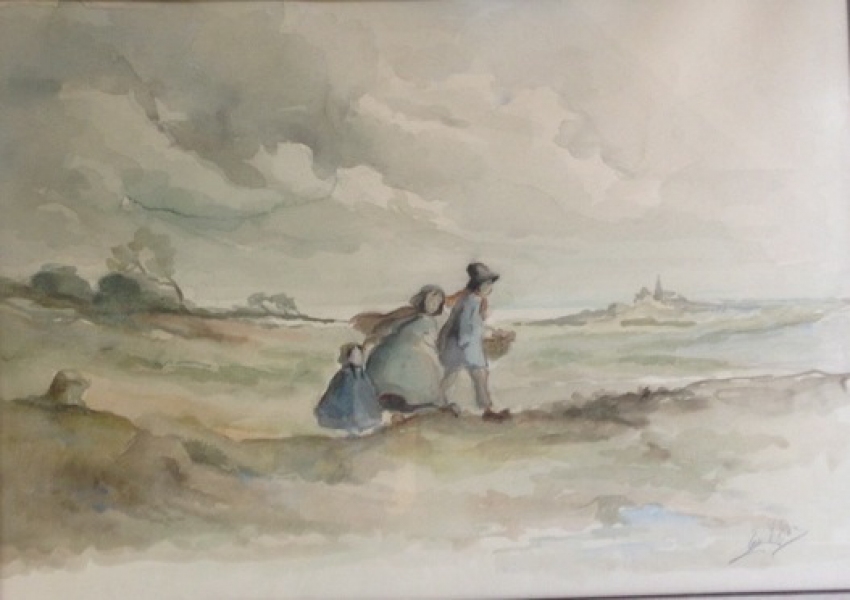Art Promotion sa
De bie eugène - oeuvres bretonnes
Presentation
De Bie was twenty in 1940. The time of the "funny war", his regiment fought on the Scheldt alongside the 137th Quimper machine gunners. The Bretons speak fervently of their native land. Friendships are forming and the promises to meet again are solemn. In 1947, DE Bie arrives in Finistère. It was love at first sight: three decades later, his home base is still Le Guilvinec, where he knows every sailor, every barcasse, every stone, every path, He lives there most of the year, applying to avoid what usually makes the life of an artist; it is because he feels that life is too short to realize everything he wears in him: then vernissages, socialities ...
Brittany, however, was the witness of his initial misery, the time when, without resources, he sacrificed his sheets to make canvases, and chairs to frame them.
But the time of lean cows forgotten, Brittany remains the land of foaming waves, Pardons, low houses, mysterious stones, equivocal lights.
De Bie, born under the sign of the fish, is nevertheless an extrovert who amplifies everything, the pains but also the joys and all the sensations.
L.M. 1980
THE CHAPEL OUR LADY OF JOY (PENMARC)
And here comes Brittany. Under a still moving sky, carrying heavy clouds, a procession is organized on the forecourt of the chapel. A chapel beaten by the waves and the wind which assures as a transition between the man and the ocean, between the earth and the water, between the human and the divine.
The Breton works of Eugène De Bie have a rather earthy roughness that is often illuminated with heightened white or colors, as here the women's headdresses and orange roof on the right of the table.
DIDIER PATERNOSTER
A BRETON WORK OF BIE ENTERS THE VATICAN MUSEUMS
Breton Pietà - gouache - 50 x 65 cm
A work by the Belgian painter Eugène De Bie is now part of the Vatican collections. This is a "Pietà en Bretagne" painted with gouache in the sixties (50 x 65 cm) which joined, a few weeks ago, the prestigious collections of the Vatican City. A great recognition for the artist who died in 1983 and whose work includes some pieces of religious art that had been gathered in a thematic exhibition at the Basilica of Koekelberg (Brussels) in 1992, exhibition whose catalog had been prefaced by Mgr. Danneels.
Other works of Eugène De Bie already appear in several religious buildings of Europe: a monumental Cross in the church Sainte-Marie-Mother-of-God in Forest (Brussels), a Way of Cross in the church Saint -Martin in Jemappes (Belgium), both classified by the IRPA "Royal Institute for the Artistic Heritage of Belgium", a Christ on the Cross in the Chapel of the Sainte-Thérèse School of Ergue-Armel (Brittany / France), a head of Christ crowned with thorns at the Convent of the Trinitarian Nuns of Valencia (Geneva / Switzerland) and a Saint Francis in the cathedral of Tempio (Sardinia / Italy).We know how much the discovery of Brittany was decisive in the personal and artistic career of Eugène De Bie. The harsh life of the fishermen, the landscapes beaten by the ocean and the wind, but also the imprint of innumerable legends and the omnipresence of the witnesses of the religious history, the calvaries in particular, had a certain impact on the imagination of the painter. The Vatican "Pietà" belongs to this Breton vein and revives a narrative that places the life of Christ in a local context and no longer a historical one, hence its name of "Breton Pietà". Far from emphatic and militant evocations, De Bie's "Pietà" attempts to evoke the affliction in an intimate scene that some protagonists clearly affirm, by their traditional costume, the transposition of a moment in the life of Christ into a another time and another place. By its clear and removed composition, clear colors and its ascensional dynamic, the "Pietà Breton" gives an intimate and powerful vision of the sufferings of Christ.
DP
https://fr.artprice.com/#
His work
Bretin
(22x16,5)
Buy this artwork
Buy this artwork
Children in the breton moor
(31x44)
Buy this artwork
Buy this artwork
Old breton woman praying in perros hamon chapel
(35 x 23,5)
Buy this artwork
Buy this artwork
Breton interior
(22x29)
Buy this artwork
Buy this artwork
Breton woman
(50x40)
Buy this artwork
Buy this artwork
Breton village (ca 1948)
(33x48)
Buy this artwork
Buy this artwork
The old fisherman
(20x13)
Buy this artwork
Buy this artwork
Between friends
(54x64)
Buy this artwork
Buy this artwork
The snack
(46x61)
Buy this artwork
Buy this artwork
The fright of the fisherman
(60x50)
Buy this artwork
Buy this artwork
Fisher child
(47x32)
Buy this artwork
Buy this artwork
Breton walk
(50X70)
Buy this artwork
Buy this artwork
The rising of the little breton
(31x41)
Buy this artwork
Buy this artwork
The despair
(31x25)
Buy this artwork
Buy this artwork
Pietà breton (collection of vatican museums)
(60x80)
Buy this artwork
Buy this artwork
Port and city of guilvinec
Bohemian famille
(80X70)
Buy this artwork
Buy this artwork
Breton village under the storm (ca 1980)
(30x40)
Buy this artwork
Buy this artwork




















